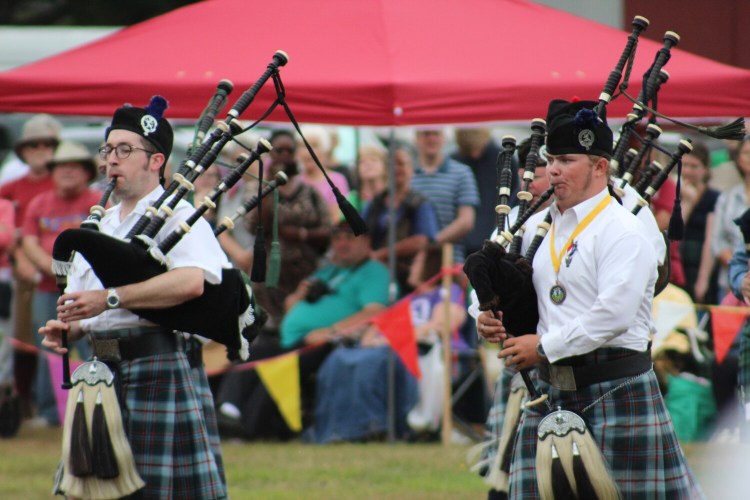TOPSHAM — Walking into the fairgrounds beneath overcast skies, surrounded by kilts, caps and highland regalia with the sound of bagpipes closing in, it was easy to imagine that Scotland itself was a few steps away.
The 41st annual Maine Highland Games and Scottish Festival on Saturday drew people from all over to participate in and watch feats of strength, sample traditional Scottish food (yes, that includes haggis), listen to music and stories, and share in a day devoted to keeping their heritage alive.

Jeff Kaste competes in the “heavyweight for distance” competition at the Maine Highland Games on Saturday. Times Record photo by Hannah LaClaire
There were numerous kilts on display Saturday, in bright reds and deep greens, each representing a different clan. The clan tradition is an important one, dating back centuries. The clans were originally extended networks of families with loyalties to a particular chief. There can be many family names under a clan’s umbrella.
“Since the battle of Culloden, a lot of Scottish culture died out,” said Sheryl Simpson, a member of clan Fraser. In 1746, Scottish Jacobite supporters (who rebelled hoping to restore Charles Stuart to the British throne) gathered to fight the Duke of Cumberland’s troops on Culloden Moor. In less than an hour, at least 1,600 men were killed — 1,500 of them Jacobites, according to the National Trust of Scotland. More were killed in the coming days.
The defeat ultimately led to the collapse of the clan system in Scotland. Even wearing a tartan was illegal for more than 30 years following the battle. But when highlanders started emigrating to the colonies, Simpson said, they brought many of their traditions with them, allowing the culture to carry over today.
“It’s history, we can still learn a great deal from it,” she said.
Simpson’s clan, Fraser, has become one of the most well-known clans in recent years, thanks to the best-selling book series by Diana Gabaldon and Starz show “Outlander,” which features Scottish highlander Jamie Fraser and his time-traveling wife, Claire. Simpson had a cutout of Jamie Fraser, played by Sam Heughan, in her clan tent on Saturday, and her wolfhound, Rollo, is named after the dog in the series.
“We love the attention,” Simpson said, “We love Jamie.”
Jamie Fraser is a fictional character, but his grandfather, Simon Fraser, the 11th Lord Lovat, was a real man. He was set to be executed for his role in the uprising in 1747, and was awaiting his beheading when the scaffolding collapsed, Simpson said, and he started laughing. It is, she said, where the expression “laughing your head off” comes from.
Fraser was just one of more than 30 clans represented at the games, with hundreds of people sporting their own family tartans.

Brian, “Ian,” Lily and Kristin Scribner, from Rhode Island, represent clan Innes at the Maine Highland Games and Scottish Festival on Saturday. “Ian” is their highlander mascot. Brian, Ian and Kristen Scribner wear the Innes red tartan, while Lily Scribner sports the clan’s hunting tartan. Times Record photo by Hannah LaClaire
This year’s honored clan was clan Donnachaidh, also known as clan Robertson. It’s among the oldest clans in Scotland, dating back to before 1300, though George Newell, clan secretary of the Highland Games, said it goes back to the 600s.
Far newer, though no less proud, was the Henderson clan, only incorporated as a full clan in 1988, having previously been a subsection of several other clans. Though new, they were no less enthusiastic or proud of their heritage. Mark Henderson represented his clan on Saturday, wearing a belt with several small bottles of Scotch whiskey strapped two it. His dogs, Oscar and Mia, were wearing their very own kilts in the Henderson colors. Though they look like ordinary dachshunds, Henderson joked they are actually “low back haggis hunting hounds.”
Brian, Kristin and Lily Scribner, representing clan Innes, said they got hooked on highland game events more than 10 years ago. They enjoy talking to people about their clan’s history. For example, clan Innes does not have a chief, Brian Scribner said.The last chief, James Innes-Ker, was born James Innes in 1736 but changed his name when he inherited the title Duke of Roxburghe, and because of the hyphenated name, Lord Lyon, Scotland’s Heraldic Authority, will not recognize his ancestors as clan chiefs.
“It’s who we are, and if we don’t honor it, it’s like a part of us that doesn’t exist,” Brian Scribner said.
Send questions/comments to the editors.



Success. Please wait for the page to reload. If the page does not reload within 5 seconds, please refresh the page.
Enter your email and password to access comments.
Hi, to comment on stories you must . This profile is in addition to your subscription and website login.
Already have a commenting profile? .
Invalid username/password.
Please check your email to confirm and complete your registration.
Only subscribers are eligible to post comments. Please subscribe or login first for digital access. Here’s why.
Use the form below to reset your password. When you've submitted your account email, we will send an email with a reset code.